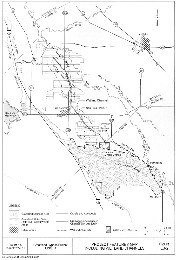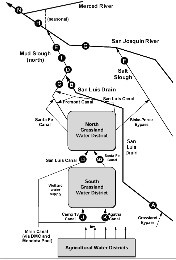- Reclamation
- California-Great Basin
- Area Offices
- SCCAO
- Grassland Bypass Project
Grassland Bypass Project
The Project prevents discharge of subsurface agricultural drainage water into wildlife refuges and wetlands in central California . The drainage water is conveyed instead through a segment of the San Luis Drain to Mud Slough, a tributary of the San Joaquin River .
The Project improves water quality in the wildlife refuges and wetlands, sustains the productivity of 97,000 acres of farmland, and fosters cooperation between area farmers and regulatory agencies in drainage management reduction of selenium and salt loading.
The Project is operated by the Bureau of Reclamation and the San Luis & Delta-Mendota Water Authority (Authority).

Figure ES-2 Project features map (PDF - 435 KB)
Background
Before the Project began in 1996, drainage water from farms in the 97,000 acre Grassland Drainage Area was discharged into Salt Slough and other channels used to deliver water to wetland areas. This drainage water contains high concentrations of selenium, salts, and other constituents that are harmful to wildlife.
The California Regional Water Quality Control Board, Central Valley Region, issued a Waste Discharge Requirement (WDR) that specified the maximum monthly and annual loads of selenium that the Project may discharge into Mud Slough and the San Joaquin River . The WDR includes monthly monitoring for molybdenum and nutrients (nitrate, ammonia, total Kjedahl nitrogen, total phosphate, and ortho-phosphate); weekly analyses of salinity, selenium, boron, and other parameters, and chronic toxicity testing. The WDR also outlines a program to monitor storm water releases from the Grassland Drainage Area into the Grassland wetland supply channels should they occur.
The Use Agreement between Reclamation and the Authority specifies the conditions for use of the San Luis Drain for the Project, and further specifies the maximum monthly and annual loads of salt that can be discharged by the Project.
Data from the Project’s monitoring program are collected and reviewed by staff from the U.S. Fish and Wildlife Service, Environmental Protection Agency, Central Valley Regional Water Quality Control Board, California Department of Fish and Game. The data are published by the San Francisco Estuary Institute. Monthly data reports and annual reports are available on the Institute’s web site.

Diagram of Monitoring Sites (PDF - 253 KB)
Accomplishments
Since implementation of the Project, all discharges of drainage water from the Grassland Drainage Area into wetlands and refuges have been eliminated. The Project has reduced the load of selenium discharged from the Grassland Drainage Area by 61percent (from 9,600 lbs to 3,700 lbs). The load of salts has been reduced by 39 percent (from 187,300 tons to 113,600 tons).
Prior to the Project, the monthly mean concentration of selenium in Salt Slough was 16 parts per billion. Since October 1996, the concentration has been less than the water quality objective of 2 parts per billion.
Note: documents in Portable Document Format (PDF) require Adobe Acrobat Reader 5.0 or higher to view download Adobe Acrobat Reader.

